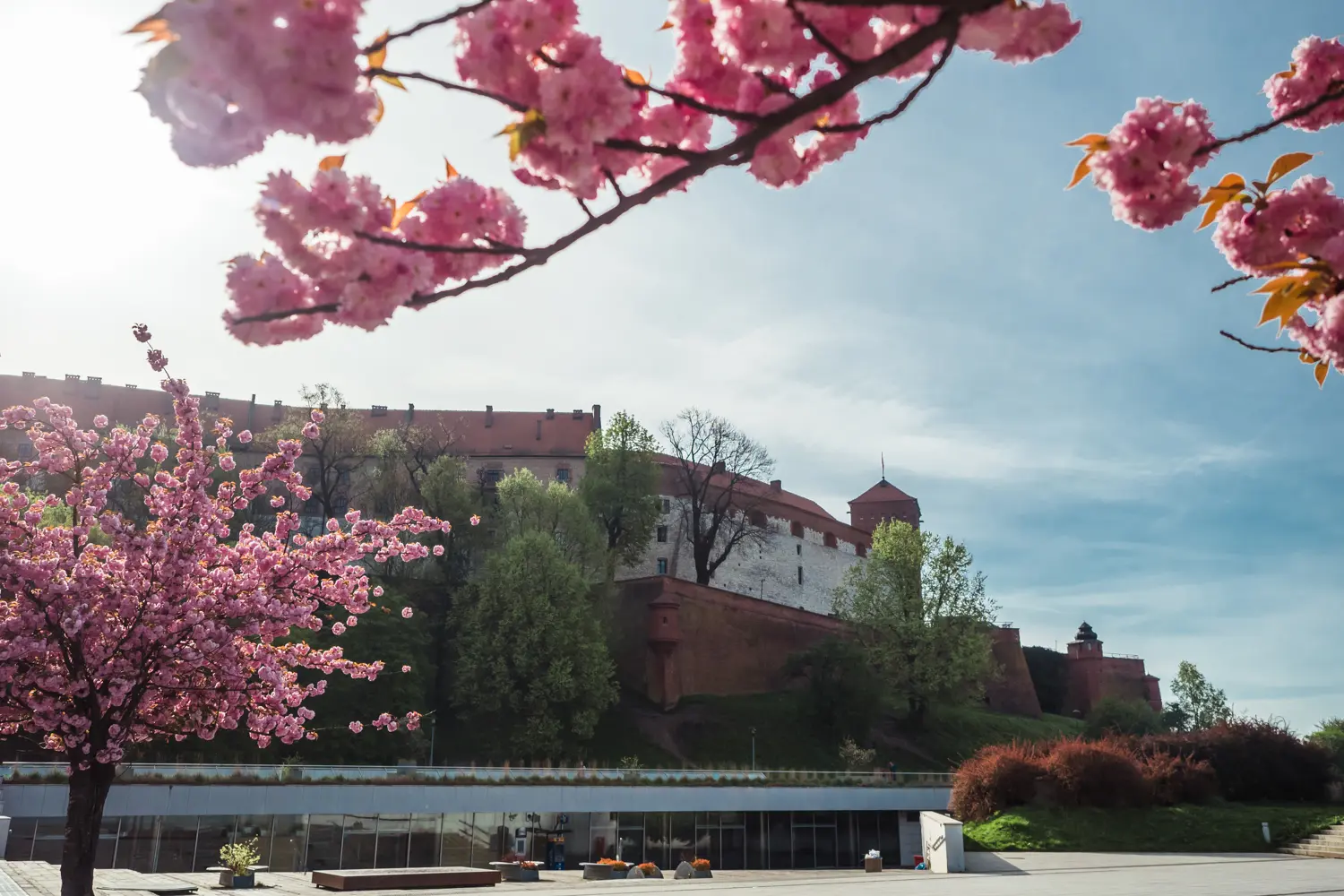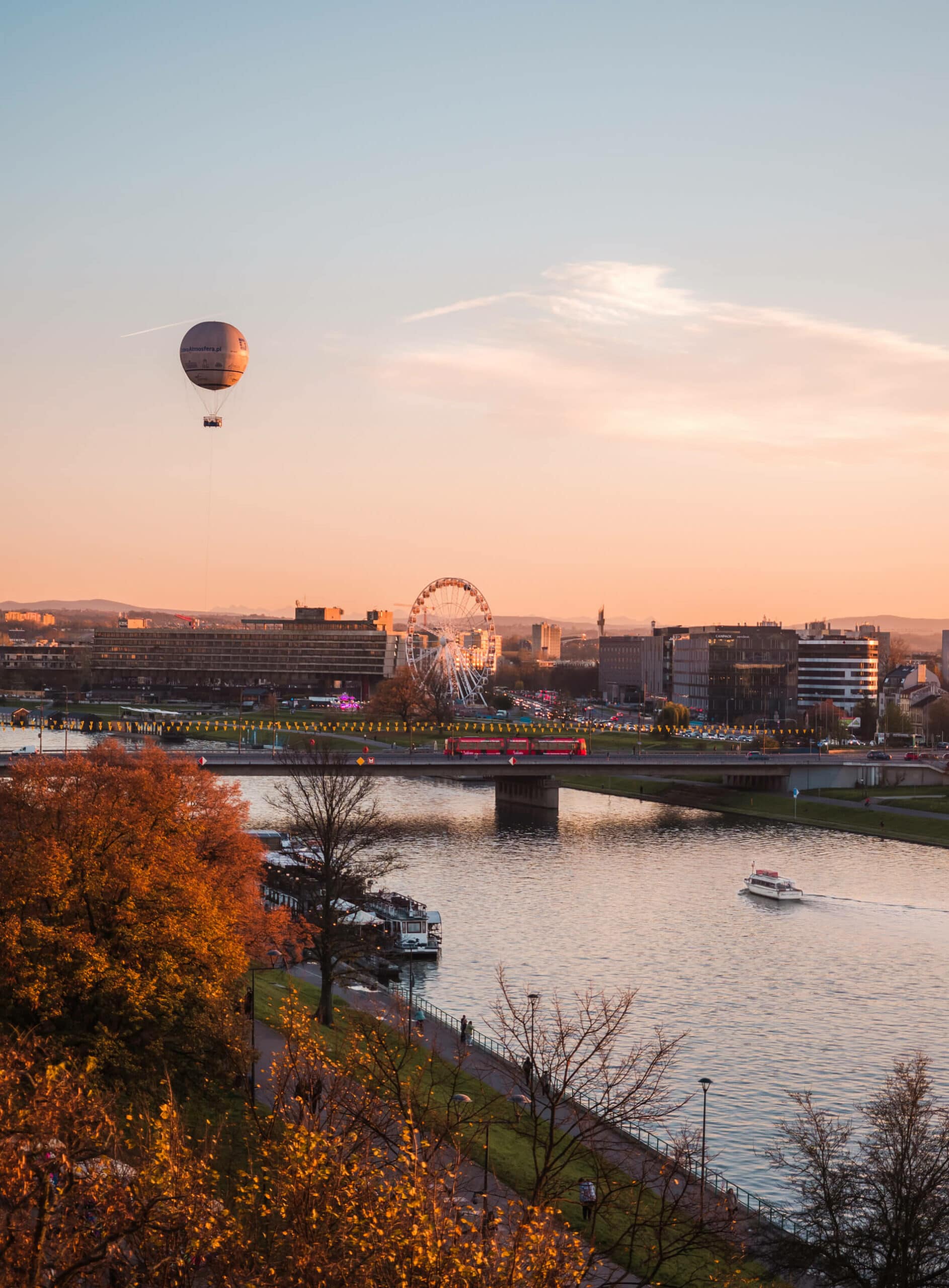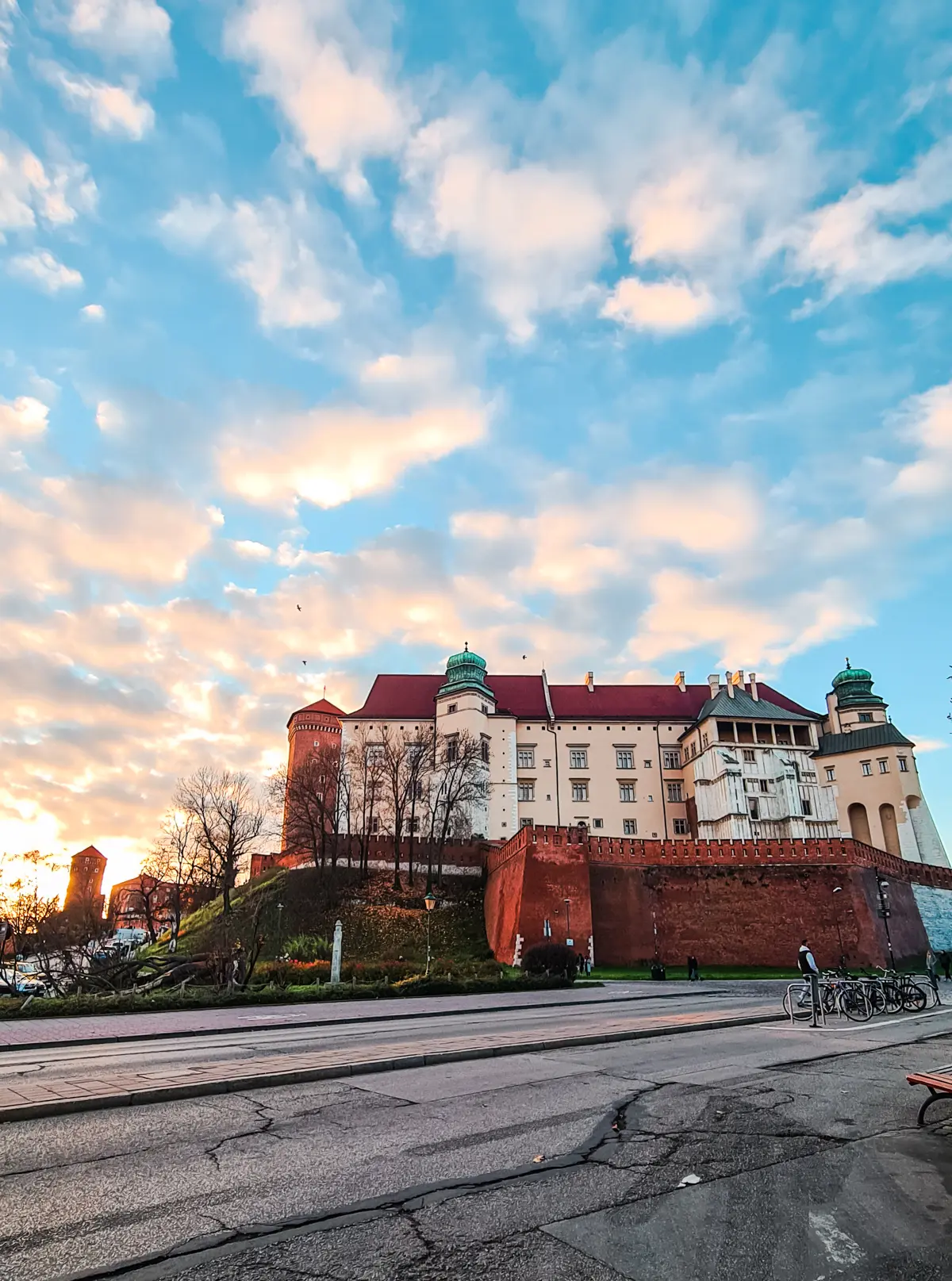Krakow, one of my favorite European cities, is home to a beautiful architectural masterpiece – Wawel Castle and Cathedral on Wawel Hill. The imposing Medieval complex dominates the city’s skyline.
I used to live in Krakow and have visited countless times since, so this place holds a special place in my heart. I can’t tell how many times I’ve watched the sunset and even sunrise over the Vistula River from the walls of Wawel Castle.
Walking through its historic halls and courtyards, you can almost feel the echoes of the past, from royal coronations to legendary tales of dragons.
Whether you’re a history lover like me and want to explore every room and tower, or you simply want to walk the grounds and enjoy the panoramic views, let’s take a closer look at why visiting Wawel Castle is a must while in Krakow.

Article overview
How to get to Wawel Castle
Wawel Castle is prominently located on Wawel Hill, a limestone outcrop on the bank of the Vistula River in the heart of Krakow. Its central location makes it easily accessible on foot from most parts of central Krakow.
If you’re staying in Kazimierz, which I highly recommend, you can walk here along the river in under 15 minutes. You can also take trams 8,13 and 72. Buy your tickets on the tram or at the stop and don’t forget to validate it.
Getting from Krakow Airport to the city center is convenient with bus, train, taxi, ride-shares or private transfers.



Wawel Castle history
Its story begins in the early Middle Ages when it served as the residence of Polish kings and the political seat of the country. One of the most significant builders of Wawel Castle was King Casimir III the Great, who reigned from 1333 to 1370.
During the 16th century, under the reign of King Sigismund I the Old and his Italian wife, Queen Bona Sforza, the castle flourished as a Renaissance masterpiece. However, its glory days as a royal residence came to an end in the 17th century when the Swedish invasions and subsequent partitions of Poland led to its decline.
Despite these turbulent times, Wawel Castle has been meticulously restored and today stands as a testament to Poland’s resilience and rich cultural history. It’s not just a castle; it’s a living museum where every stone tells a story.
Wawel Castle legends
One of the most famous legends is that of a fearsome dragon who lived in a cave beneath the castle, terrorizing the city and devouring livestock and unwary villagers.
The dragon was eventually slain by a clever shoemaker’s apprentice named Krakus, who tricked the beast into eating a sheep stuffed with sulfur. After the dragon drank from the Vistula River to quench its burning thirst, it exploded, freeing the city from its tyranny.
Today, a statue of the Wawel Dragon stands below the castle, breathing fire every 5-10 minutes.
Another intriguing legend involves the mysterious Chakra Stone, believed to be one of the earth’s seven main energy points, located somewhere under St. Gereon’s Chapel. Some say that it was placed there by ancient Hindu priests, while others believe it was brought to Krakow by King Casimir the Great.

Wawel Castle visitor’s info
Here is everything you need to know for a smooth visit to Wawel Castle.
Entrances
Wawel Castle has two main entrances: The Herbowa Gate from Podzamcze Street, also known as the Gate of the Coat of Arms, is the primary entrance, leading directly to the castle’s main courtyard. It is the closest entrance to the closest to the Old Town.
The Bernardyńska Gate, located on the southern side, provides an alternative entrance, often used by those coming from the direction of the Vistula River and Kazimierz.


Opening hours
Wawel Hill is open to visitors every day from 6:00 am until dusk (closing time varies with the season). The castle courtyard opens to visitors at 7:00 am and closes 30 minutes before the gates.
Wawel Castle’s Visitors Center is open Mondays from 9:00 am to 7:00 pm and Tuesday – Sunday from 8:30 am to 7:00 pm.
Generally, the castle interiors open at 9:00 am with the last admission at 4:00 pm. The Crown Treasury and Armoury is open a little later.
The cathedral typically opens at 9:00 am and closes around 5:00 pm, with shorter hours on Sundays and religious holidays.
Is it free to visit Wawel Castle?
Yes, you can visit most of the castle grounds for free, which to me is the highlight. There’s also free admission to several exhibitions on Mondays (April – October) from 9:30 am – 1:00 pm and Sundays (December – March) from 10:00 am – 4:00 pm.

Wawel Castle tickets
Tickets can be purchased at the on-site ticket office or online through the official Wawel Castle website. I always book tickets in advance or join a guided tour, especially during peak tourist seasons, to avoid long lines.
Reduced ticket prices are available for students, seniors, children, and groups. Make sure to bring appropriate identification to avail of these discounts.
Audioguides are available for the Royal Private Apartments, State Rooms, Crown Treasury, Armoury and the Lapidarium – in English, Polish, Ukrainian, German, French, Italian and Spanish.
Best guided tours
🌟 This 2-hour small-group tour of Wawel Castle and Cathedral offers great value, with skip-the-line tickets for one of the permanent exhibitions and the cathedral. You will also get a guided tour of the grounds. I learned a lot from my guide Helena, even though I have visited many times on my own.
🌟 This is the best tour for my fellow history lovers, Magdalena is such a knowledgeable guide. You can choose to see the entire complex, which takes around 4.5 hours, or just certain areas of the castle. Avoid the long lines with a special skip-the-line admission ticket, which during the busy summer months is such a treat.
Is Wawel Hill & Castle accessible?
Wawel Hill has made efforts to accommodate visitors with mobility challenges, including ramps. Both entrances, though steep, are accessible, and so are most of the castle grounds.
However, exhibitions on the first and second floors of the castle (State Rooms, Royal Private Apartments, Oriental Art, and the second floor) are currently not wheelchair accessible. A wheelchair lift is in the works.
In the Armoury, only the ground floor is accessible, and the Lost Wawel exhibition is partially wheelchair-accessible (Lapidarium and Tile Room).


Wawel Hill areas & exhibitions
- State Rooms: This is the castle’s main exhibition. These opulent rooms display the grandeur of the royal court with exquisite tapestries, paintings, and Italian Renaissance furniture.
- Royal Private Apartments: This was the highlight of the interiors for me, to get a look at the private lives of the Polish monarchs. Decorated with beautiful artwork, porcelain, patterned tiles, ornate furniture and personal items.
- Crown Treasury and Armory: The treasury is my second favorite exhibition, it features a stunning collection of royal regalia, including crowns, scepters, and ceremonial swords. The armory displays an array of weaponry and armor, illustrating the military history of Poland.
- Oriental Art: This unique exhibition showcases a fascinating collection of artifacts from the Middle East, the Far East and North Africa. Items on display include tents, textiles, ceramics, weaponry, and other decorative arts.
- Castle Underground: Includes Lost Wawel, Lapidarium (with audio guide) and seasonal Church of St. Gereon and Royal Gardens. This exhibition delves into the archaeological history of Wawel Hill, presenting artifacts and architectural remnants from various periods, from the 11th through the 17th century.
- Wawel Recovered: This exhibition focuses on the restoration and preservation efforts that have taken place at Wawel Castle from Poland’s loss of independence in 1795 to the present day. It is housed in the medieval interiors of a group of Gothic buildings on the north side of Wawel Hill.
- Sandomierska Tower: The Sandomierska Tower, one of three the most prominent defensive structures at Wawel Castle, dates back to 1460 and offers stunning panoramic views of Krakow and the Vistula River.
- Royal Gardens: The gardens, reconstructed based on extensive research on Renaissance gardens, encompass an upper and lower terrace and a small vineyard.
- Arcaded Galleries (inner courtyard) and viewing platform: From the new observation deck on the roof of the Small Tower, you can admire the stunning panorama of the castle complex and its surroundings.
- Dragon’s Den: Walk through the limestone cave beneath the castle that is said to have been the lair of the dragon I mentioned earlier. Do this last, as the exit is outside the castle walls.





Wawel Cathedral & John Paul II Cathedral Museum
Wawel Cathedral, officially known as the Archcathedral Basilica of Saint Stanislaus and Saint Wenceslaus, is one of Poland’s most significant religious and historical landmarks. It has witnessed numerous royal coronations, weddings and funerals.
The cathedral’s architecture is a stunning blend of Gothic, Renaissance, and Baroque styles, reflecting the various periods of its construction and renovation. Inside, you can marvel at the intricate chapels, grand altars, and beautiful stained-glass windows.
Wawel Cathedral is also the final resting place for many of Poland’s most illustrious figures, including St. Stanislaus, the patron saint of Poland, whose relics are housed in a magnificent silver sarcophagus.
The cathedral’s bell tower is home to the famous Sigismund Bell, one of the largest bells in Poland. Climbing the tower to see the bell up close and enjoy panoramic views of Krakow is a highlight for me.
Just next to the cathedral, you’ll find John Paul II Cathedral Museum, a treasure trove of religious and historical artifacts.


What to expect on Wawel Hill
Elevated at a height of 230 meters above sea level, Wawel Hill looms dominatingly over the Old Town and Kazimierz districts that it separates.
Take your time to truly take in the magic of the place, close your eyes, and pretend you step back in time to when the Royals were still living here. It is something I love to do.
I can walk around the gorgeous ground for hours, preferably early in the morning or at sunset. The view across the Vistula River to the Krakow Eye Ferris Wheel and the Observation Balloon is also spectacular.
So can you see why Wawel Castle is an absolute must during your weekend in Krakow?
Pro tip >> There is a large, incredible Magnolia tree in the middle of the grounds that usually blooms at the beginning of April. I just missed it this year because it got warm so early, but it would be the perfect backdrop for photos.
During the warmer months, the lawn along the river on the northwest side of Wawel Castle is a popular place for a picnic. Bring a blanket and some takeout, and enjoy the view of Wawel Castle and boats floating by.



Architecture
What makes Wawel Castle so unique is the mix of architectural styles. The complex contains a myriad of royal, religious and fortified buildings that date from various periods of construction, beginning in the 11th century.
Gothic style: The earliest significant construction of Wawel Castle began in the 14th century under the reign of King Ladislaus I the Short and his son King Casimir III the Great. They built an imposing Gothic residence comprising several buildings grouped around an irregular courtyard in the east wing (photo above right).
Renaissance influence: The 16th century marked a golden age for Wawel Castle when Italian architects and artists were invited to Krakow, leading to a significant Renaissance transformation. The castle’s grand courtyards, with their elegant arcades and loggias, are prime examples of this influence. The Sigismund Chapel is often referred to as “the purest example of Renaissance architecture outside Italy”.
Baroque additions: In the 17th and 18th centuries, the castle saw Baroque additions, particularly in the interior decorations and some of the chapels. The Baroque style is known for its dramatic use of light and shadow, intricate detailing and grandeur.
Romanesque remnants: While Gothic, Renaissance, and Baroque styles dominate the castle, there are remnants of earlier Romanesque architecture, particularly in the Wawel Cathedral. The Romanesque style, with its rounded arches and sturdy, massive structures, can be seen in the crypts and some of the oldest parts of the cathedral.

Wawel castle amenities
- Dining: There is one café and one restaurant in Wawel Castle, both with outdoor seating during the summer months. The Trattoria with more substantial meals is located on the other side of the building above. In addition, you’ll find several of the best restaurants in Krakow just minutes from the castle.
- Visitor information center: Located near the main entrance, the center provides essential information about the castle, including maps, brochures, and details about exhibitions, tours, and events. The staff can also assist with ticket purchases and general inquiries.
- Gift shops: Several gift shops are scattered throughout the Wawel Hill complex, offering a variety of souvenirs, books, prints, cards and “gold” coins that I collect.
- Restrooms: Modern restroom facilities are available in the visitor’s center and through a gate in the main courtyard.
- Seating areas: Benches and seating areas are strategically placed around the grounds, allowing visitors to rest and enjoy the beautiful surroundings.
- Post office: Yes, there is even a Post Office located in the Thieves’ Tower, where you can send cards to your loved ones.

Other castles outside Krakow
Another perspective on Wawel Castle, I shot this during a river cruise on the Vistula River. I also recommend checking out the greater Krakow area, which is home to some of the most beautiful castles in Poland.
One of my favorite days I’ve ever had in Poland was a road trip on the Trail of the Eagle’s Nests, a scenic and historic route that stretches between Krakow and Częstochowa. It features a series of medieval castles, ruins and watchtowers perched on limestone cliffs.
This picturesque trail, named for the lofty positions of these fortifications, offers visitors a unique opportunity to explore Poland’s medieval heritage while enjoying stunning natural landscapes.
You can combine your ticket to Wawel Castle with Pieskowa Skała Castle, located in the picturesque Ojców National Park. It is one of the most beautifully preserved Renaissance fortresses in Poland, offering stunning views and a rich collection of art and artifacts.
When the weather is nice, rent a bike and follow the river to Tyniec Abbey, one of the most beautiful hidden gems in Krakow.
🤩 Read next >> Where to stay in Krakow (30+ hotels & apartments later)










Leave a Reply